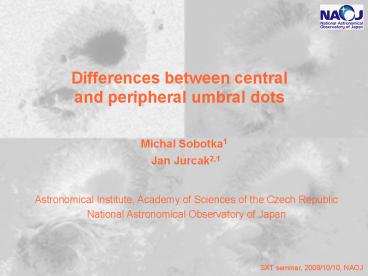Differences between central and peripheral umbral dots - PowerPoint PPT Presentation
1 / 16
Title:
Differences between central and peripheral umbral dots
Description:
In the low photosphere, CUDs have a weaker B and their LOS velocity and ... In the high photosphere, the differences between the bright features and their ... – PowerPoint PPT presentation
Number of Views:67
Avg rating:3.0/5.0
Title: Differences between central and peripheral umbral dots
1
Differences between central and peripheral
umbral dots
Michal Sobotka1 Jan Jurcak2,1
Astronomical Institute, Academy of Sciences of
the Czech Republic National Astronomical
Observatory of Japan
SXT seminar, 2008/10/10, NAOJ
2
Observations
Sunspot NOAA 10944 observed with Hinode SOT on
February 27, 2007 between 1200 UT and 1500 UT.
Heliocentric angle around 13 deg. G-band images
taken with cadence of 1min. 8 x 16
3
Observations
Sunspot NOAA 10944 observed with Hinode SOT on
February 27, 2007 between 1200 UT and 1500 UT.
Heliocentric angle around 13 deg. Repetitive
scanning of 10 wide area with SP (normal mode).
4
SIR inversion
34 consecutive SP scans of area with the size of
50 x 100 pixels was inverted. The standard
version of the SIR code was used. One-component
model of atmosphere considered. No stray-light
taken into account (so far). We allowed for the
changes of plasma parameters with height. Five
nodes was used for the temperature, magnetic
field strength and inclination, and LOS velocity.
The results were studied at two different
layers low atmosphere averaged between
log(tau) -0.2 and -0.5 high atmosphere averaged
between log(tau) -1.4 and -2.0
5
Maps of plasma parameters
LOW ATMOSPHERE
HIGH ATMOSPHERE
6
Penumbral grain
Event low atmosphere
Surroundings low atmosphere
Event high atmosphere
Surroundings high atmosphere
7
Penumbral grain peripheral umbral dot
Event low atmosphere
Surroundings low atmosphere
Event high atmosphere
Surroundings high atmosphere
8
Peripheral umbral dot
Event low atmosphere
Surroundings low atmosphere
Event high atmosphere
Surroundings high atmosphere
9
Central umbral dot
Event low atmosphere
Surroundings low atmosphere
Event high atmosphere
Surroundings high atmosphere
10
Conclusions
11
Conclusions
In the low photosphere, CUDs have a weaker B and
their LOS velocity and inclination do not differ
from the surroundings. In PGs, B is reduced
with respect to the surroundings. PGs show strong
upflows of 1 km/s and the magnetic field is more
horizontal. PGs move into the umbra with
horizontal velocities of about 400 m/s. PUDs
have a substantially higher T and a weaker B than
in the surrounding umbra. They conserve the
characteristic vertical upflows of PGs and higher
field inclination compared to the surroundings.
These parameters decrease gradually during the
motion of PUDs into the umbra. The speed of
horizontal motion of PUDs is practically equal to
that of PGs. In the high photosphere, the
differences between the bright features and their
surroundings are not so significant. The
temperature excess in PUDs indicates that PUDs
can penetrate higher in the photosphere than CUDs.
12
Evidence of convective rolls in a sunspot
penumbra V. Zakharov, J. Hirzberger, T. L.
Riethmüller, S. K. Solanki, and P.
Kobel Max-Planck-Institut für
Sonnensystemforschung, 37191 Katlenburg-Lindau,
Germany
13
Observations
NOAA 10904 2006/08/13 T 40.5 deg 2 hour long
sequence SP data obtained with Solar Optical
Universal Polarimeter 6 wavelengths in 123
s -150, -75, 0, 75,150, 250 ME inversion
applied HeLIx code
Orientation of the filament 21 deg with the
respect to the nearest limb (sin 210.36)
14
Results
Limb side of the filament shows Center side
of the filament Velocity Blueshift Weak
redshift Field strength Weker filed Strong
field Inclination Almost horizontal More
vertical Azimuth Points toward the limb (20
deg) Parallel to the filament
15
Results
16
Conclusions































